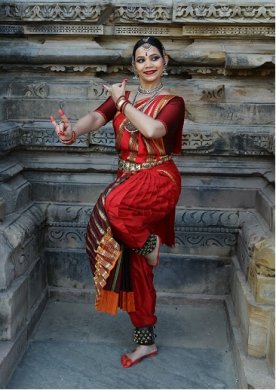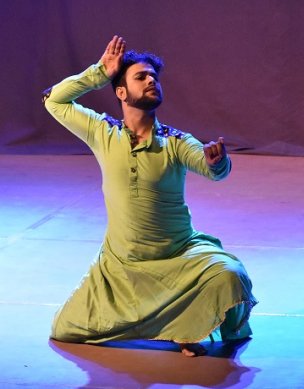
|   |

|   |
 e-mail: leelakaverivenkat@gmail.com Delhi inauguration of fine idea of Nava Pallava needs more clarity May 26, 2019 Nava Pallava, the brainchild of Ashok Jain of Spic Macay deserves all encouragement, for it aims at providing performance opportunities to young artists, who apart from being outside the charmed performance circuit, are also exploited by so called impresarios providing platforms for a fee. With this money the organizer not only pays for the venue but also earns a percentage of profit for oneself. Senior artists like Sharmila Biswas in Kolkata, Aruna Mohanty and Ratikant Mohapatra in Bhubaneswar, Parwati Dutta in Aurangabad and some others have taken up the Nava Pallava cause in earnest with highly encouraging results. New Delhi's Sangeet Shyamala stepping in to help with an inaugural event mounted at its premises is all to the good. With trustee Chetna Jalan not in station, her sister, Vasundhara Tiwari, Principal of the institution, conducted the event. But the evening, as conceived had a few confused areas. Firstly, 6pm was the time mentioned for the event with Bharatanatyam dancer Sneha Chakradhar and Kathak dancer Sudip Chakraborty as the artists for the evening. With an exhibition mounted in one of the rooms, and the chief guest arriving at about 6.30, by the time guests settled down and the show started in the basement auditorium space, it was about 7pm. Long winding, chatty introductions, in place of crisp introductory notes to be read out (not exceeding a minute and a half), took up needless time. The sealed box for people to donate (as and if they so wished), opened in front of the audience after the show, with the collected amount distributed between the two dancers (which initially struck me as a not very sophisticated way of trying to compensate the dancers for their art efforts) apparently fetched over 13,000 rupees (!) and marked a promising beginning for people to understand that free shows with art being taken for granted was not being fair to the artist. How did one define the term Nava? Can Sneha Chakradhar, an established disciple of Geeta Chandran, who has been performing for some years, be classed as Nava? True that she has not been getting solo opportunities too often. But how many established dancers barring half a dozen who seem to have monopolised the entire field, get solo opportunities? If this is used as an argument for selection in Nava Pallava, unknown youngsters will get omitted from any consideration. And the senior dancer Sneha should have performed in the second half instead of being allotted the first slot - with almost all the audience comprising her friends walking out after her performance. The next dancer had hardly twenty people watching. Very disappointing that so little consideration exists among dancers for youngsters of their kin - with known Kathak artists who had graced the event, trooping out in full, without encouraging a youngster representing their dance tradition. Sad! Aside from being comparatively unknown, the live music accompaniment for Sudip Chakraborty entailed sound arrangements taking up a full 15 minutes before the performance could start - further delaying proceedings and depleting the audience. Sneha's recorded music should have been another strong reason for her being slated the second performer, for adjustment of sound would have taken very little time. No complaints could be made on the quality of the dance. Sneha's assured and well centered movements with strongly etched postures made a convincing curtain-raiser for the description and depiction of Shivahood - the all-embracing power and cosmic dimension and nirvana roopam of Shiva visualized in the dance based on the Rudrashtakam verses set to music in the ragamalika format.  Sneha Chakradhar  Sudip Chakraborty Despite the scanty audience, Sudip Chakraborty proved himself. His presentation of Besotted based on couple of lines of poetry put the searchlight on love, a possessed state of mind when the whole world seems to shrink into one obsession. Did love, with this "bina bulaye mehmaan" (the uninvited guest) make a slave of one or was it a liberating force? 'Make me a force that harmonises,' begs the one in the grip of love. What this critic found very encouraging was the way nritta was knitted and interwoven with the interpretative, and how the dancer had taken pains to conceive the whole theme. In the end love is nothing but total surrender and this was illustrated through Jayadeva's Gita Govind verses, where Krishna declaring his love for Radha in a final act of complete surrender (banishing all high and low considerations) beseeches that Radha place her foot on his head, "Dehi pada pallavamudaram" to remove all the poison of disagreement from his person, that had hitherto thwarted their love story. The dancer's interpretative talent which is obvious is bound to mature to greater sophistication with time. Urdu poetry, English soliloquy spoken into the mike, and then the Sanskrit verses when used in one composition, must follow in a manner without causing a jerk in the fluidity of the narration - with experience the dancer will evolve. Sudip has talent and it is not often that one finds male dancers in Kathak spin a whole performance round a theme like love. The dancer ended with a brief Drut Teental, acknowledging the bandish used in this section, as having been composed by Sushmita Misra.  Writing on the dance scene for the last forty years, Leela Venkataraman's incisive comments on performances of all dance forms, participation in dance discussions both in India and abroad, and as a regular contributor to Hindu Friday Review, journals like Sruti and Nartanam, makes her voice respected for its balanced critiquing. She is the author of several books like Indian Classical dance: Tradition in Transition, Classical Dance in India and Indian Classical dance: The Renaissance and Beyond. Comments * Leela Ji, As a practitioner of Kathak, I have worked with Mr. Ashok Jain previously through Spic Macay. I pose this question. If aim of Nava Pallava is to discourage pay and perform model, then how is this any different? The correct way forward would be to encourage corporations, NGO's and increase government support to support such platforms. In my understanding this is just another example of the same, where an artist is paying for other artists to perform. I am a supporter of presenting new platforms for younger talent as they need encouragement, but is this the way? Looking forward to your positive response. Thanks, With much appreciation Astha Dixit (April 4, 2021) Post your comments Please provide your name and email id when you use the Anonymous profile in the blog to post a comment. All appropriate comments posted with name & email id in the blog will also be featured in the site. |